

 |
Measuring correlations from the collective spin fluctuations of a large ensemble of lattice-trapped dipolar spin-3 atomsWe perform collective spin
measurements to study the buildup of two-body correlations
between |
 |
Measuring densities of cold atomic clouds smaller than the resolution limitWe propose and demonstrate an experimental method to measure by absorption imaging the size and local column density of a cloud of atoms, even when its smallest dimension is smaller than the resolution of the imaging system. To do this, we take advantage of the fact that, for a given total number of atoms, a smaller and denser cloud scatters less photons when the gas is optically thick. The method relies on making an ansatz on the cloud shape along the unresolved dimension(s), and on providing an additional information such as the total number of atoms. We demonstrate the method on in-situ absorption images of quasi-1D 87Sr Fermi gases. We find significant non-linear corrections to the estimated size and local density of the cloud compared to a standard analysis. This allows us to recover an un-distorted longitudinal density profile, and to measure transverse sizes as small as one fourth of our imaging resolution. The ultimate limit of our method is the wavelength that is used for imaging. |
 |
Relaxation of the Collective Magnetization of a Dense 3D Array of Interacting Dipolar S=3 AtomsWe report on measurements of the dynamics of the total magnetization and spin populations in an almostunit-filled lattice system comprising about 104 spin 3 chromium atoms, under the effect of dipolar interactions. The observed spin population dynamics is unaffected by the use of a spin echo and fullyconsistent with numerical simulations of the XXZ spin model. On the contrary, the observed magnetization decays slower than in simulations and, surprisingly, reaches a small but nonzero asymptoticvalue within the longest timescale. Our findings show that spin coherences are sensitive probes tosystematic effects affecting quantum many-body behavior that cannot be diagnosed by merely measuring spin populations. |
 Three-pulse spin and momentum resolved picture of a five-component Sr gas |
Adiabatic spin-dependent momentum transfer in an SU(N) degenerate Fermi gasWe introduce a spin-orbit coupling scheme, where a retro-reflected laser beam selectively diffracts two spin components in opposite directions. Spin sensitivity is provided by sweeping through a magnetic-field sensitive transition while dark states ensure that spontaneous emission remains low. The scheme is adiabatic and thus inherently robust. This tailored spin-orbit coupling allows simultaneous measurements of the spin and momentum distributions of a strontium degenerate Fermi gas, and thus opens the path to momentum-resolved spin correlation measurements on SU(N) quantum magnets. |
 |
Shelving spectroscopy of the strontium intercombination lineWe
present a spectroscopy scheme for the 7-kHz-wide 689-nm
intercombination line of strontium. We rely on shelving
detection, where electrons are first excited to a
metastable state by the spectroscopy laser before their
state is probed using the broad transition at 461 nm. As
in the similar setting of calcium beam clocks, this
enhances dramatically the signal strength as compared to
direct saturated fluorescence or absorption spectroscopy
of the narrow line. We implement shelving spectroscopy
both in directed atomic beams and hot vapor cells with
isotropic atomic velocities. We measure a fractional
frequency instability |
 |
Dynamics of an itinerant spin-3 atomic dipolar gas in an optical latticeArrays of ultra-cold dipolar gases loaded in optical lattices are emerging as powerful quantum simulators of the many-body physics associated with the rich interplay between long-range dipolar interactions, contact interactions, motion, and quantum statistics. In this work we report on our investigation of the quantum many-body dynamics of a large ensemble of bosonic magnetic chromium atoms with spin S = 3 in a three-dimensional lattice as a function of lattice depth. Using extensive theory and experimental comparisons we study the dynamics of the population of the different Zeeman levels and the total magnetization of the gas across the superfluid to the Mott insulator transition. We are able to identify two distinct regimes: At low lattice depths, where atoms are in the superfluid regime, we observe that the spin dynamics is strongly determined by the competition between particle motion, on site interactions and external magnetic field gradients. Contact spin dependent interactions help to stabilize the collective spin length, which sets the total magnetization of the gas. On the contrary, at high lattice depths, transport is largely frozen out. In this regime, while the spin populations are mainly driven by long range dipolar interactions, magnetic field gradients also play a major role in the total spin demagnetization. We find that dynamics at low lattice depth is qualitatively reproduced by mean-field calculations based on the Gutzwiller ansatz; on the contrary, only a beyond mean-field theory can account for the dynamics at large lattice depths. While the cross-over between these two regimes does not correspond to sharp features in the observed dynamical evolution of the spin components, our simulations indicate that it would be better revealed by measurements of the collective spin length. |
 |
Cooling All External Degrees of Freedom of Optically Trapped Chromium Atoms Using Gray MolassesWe report on a scheme to cool and compress trapped clouds of highly magnetic 52Cr atoms. This scheme combines sequences of gray molasses, which freeze the velocity distribution, and free evolutions in the (close to) harmonic trap, which periodically exchange the spatial and velocity degrees of freedom. Taken together, the successive gray molasses pulses cool all external degrees of freedom, which leads to an increase of the phase-space density (PSD) by a factor of about 250, allowing to reach a high final PSD of about 1.7*10^-3. These experiments are performed within an optical dipole trap, in which gray molasses work equally well as in free space. The obtained samples are then an ideal starting point for the evaporation stage aiming at the quantum regime. |
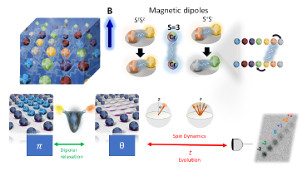 |
Exploring out-of-equilibrium quantum magnetism and thermalization in a spin-3 many-body dipolar lattice systemHere we experimentally study the dynamics and approach towards thermal equilibrium of a macroscopic ensemble of spins initially tilted compared to the magnetic field, under the effect of dipole-dipole interactions. The experiment uses a unit filled array of 10^4 chromium atoms in a 3D optical lattice, realizing the spin-3 XXZ Heisenberg model. We monitor the population of the seven spin components after a collective rotation of an initially polarized ensemble, as a function of the angle between the initial coherent state with respect to the magnetic field. We find that the approach to thermal equilibrium is increasingly driven by quantum correlations as the angle approaches pi/2. Nature Comm. 10, 1714 (2019) |
 |
Dissipative cooling of spin chains by a bath of dipolar particlesWe consider a spin chain of fermionic atoms in an optical lattice, interacting with each other by super-exchange interactions. We theoretically investigate the dissipative evolution of the spin chain when it is coupled by magnetic dipole-dipole interaction to a bath consisting of atoms with a strong magnetic moment. Dipolar interactions with the bath allow for a dynamical evolution of the collective spin of the spin chain. Starting from an uncorrelated thermal sample, we demonstrate that the dissipative cooling produces highly entangled low energy spin states of the chain in a timescale of a few seconds. |
 |
Collective spin modes of a trapped quantum ferrofluidWe report on the observation of a collective spin mode in a spinor Bose-Einstein condensate. Initially, all spins point perpendicular to the external magnetic field. The lowest energy mode consists in a sinusoidal oscillation of the local spin around its original axis, with an oscillation amplitude that linearly depends on the spatial coordinates. The frequency of the oscillation is set by the zero-point kinetic energy of the BEC. The observations are in excellent agreement with hydrodynamic equations. The observed spin mode has a universal character, independent of the atomic spin and spin-dependent contact interactions. Phys. Rev. Lett. 121, 013201 (2018) |
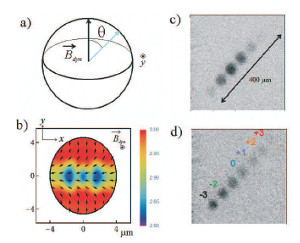 |
Spin mixing and protection of ferromagnetism in a spinor dipolar condensateWe study spin mixing dynamics in a chromium dipolar Bose-Einstein Condensate, after tilting the atomic spins by an angle ? with respect to the magnetic field. Spin mixing is triggered by dipolar coupling, but, once dynamics has started, it is mostly driven by contact interactions. For the particular case ? = p / 2 , an external spin-orbit coupling term induced by a magnetic gradient is required to enable the dynamics. Then the initial ferromagnetic character of the gas is locally preserved, an unexpected feature that we attribute to large spin-dependent contact interactions. |
 |
Competition between Bose Einstein Condensation and spin dynamicsWe study the impact of spin-exchange collisions on the dynamics of Bose-Einstein condensation, by rapidly cooling a chromium multi-component Bose gas. Despite relatively strong spin-dependent interactions, the critical temperature for Bose-Einstein condensation is reached before the spin- degrees of freedom fully thermalize. The increase in density due to Bose-Einstein condensation then triggers spin dynamics, hampering the formation of condensates in spin excited states. Small metastable spinor condensates are nevertheless produced, and manifest strong spin fluctuations. |
 |
Probing spin dynamics from the Mott
insulating to the superfluid regime in a dipolar
|
 |
Cooling of a Bose-Einstein Condensate by spin distillationWe propose and experimentally demonstrate a new cooling mechanism leading to purification of a spinor Bose-Einstein Condensate (BEC). Our scheme starts with a BEC polarized in the lowest energy spin state. Spin excited states are thermally populated by lowering the single particle energy gap set by the magnetic field. Then these spin-excited thermal components are filtered out, which leads to an increase of the BEC fraction. We experimentally demonstrate such cooling for a spin 3 chromium dipolar BEC. Our scheme should be applicable to Na or Rb, with perspective to reach temperatures below 1 nK. |
 |
Dipolar atomic spin ensembles in a double-well potentialWe experimentally study the spin dynamics of mesoscopic ensembles of ultracold magnetic spin-3 atoms located in two separated wells of an optical dipole trap. We use a radio-frequency sweep to selectively flip the spin of the atoms in one of the wells, which produces two separated spin domains of opposite polarization. We observe that these engineered spin domains are metastable with respect to the long-range magnetic dipolar interactions between the two ensembles. The absence of inter-cloud dipolar spin-exchange processes reveals a classical behavior, in contrast to previous results with atoms loaded in an optical lattice. When we merge the two subsystems, we observe spin-exchange dynamics due to contact interactions which enable the first determination of the s-wave scattering length of 52Cr atoms in the S=0 molecular channel a_0=13.5^{+11}_{-10.5}a_B (where a_B is the Bohr radius). |
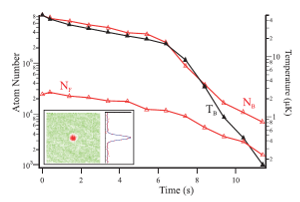 |
Chromium dipolar Fermi seaWe report on the production of a degenerate Fermi gas of Chromium 53 atoms, polarized in the state F=9/2, mF=-9/2, by sympathetic cooling with bosonic S=3,mS=-3 Chromium 52 atoms. We load in an optical dipole trap 3×10^4 Chromium 53 atoms with 10^6 Chromium 52 atoms. Despite the initial small number of fermionic atoms, we reach a final temperature of TFinal=0.6×TF (Fermi temperature), with up to 10^3 Cr53 atoms. This surprisingly efficient evaporation stems from an interisotope scattering length |aBF|=80(±10)aB (Bohr radius) which is small enough to reduce evaporative losses of the fermionic isotope, but large enough to assure thermalization. |
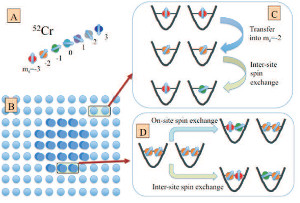 |
Non-equilibrium quantum magnetism in a dipolar lattice gasResearch on quantum magnetism with ultra-cold gases in optical lattices is expected to open fascinating perspectives for the understanding of fundamental problems in condensed-matter physics. Here we report on the first realization of quantum magnetism using a degenerate dipolar gas in an optical lattice. In contrast to their non-dipolar counterparts, dipolar lattice gases allow for inter-site spin-spin interactions without relying on super-exchange energies, which constitutes a great advantage for the study of spin lattice models. In this paper we show that a chromium gas in a 3D lattice realizes a lattice model resembling the celebrated t-J model, which is characterized by a non-equilibrium spinor dynamics resulting from inter-site Heisenberg-like spin-spin interactions provided by non-local dipole-dipole interactions. Moreover, due to its large spin, chromium lattice gases constitute an excellent environment for the study of quantum magnetism of high-spin systems, as illustrated by the complex spin dynamics observed for doubly-occupied sites. |
 |
Resonant demagnetization of a dipolar BEC in a 3D optical latticeWe study dipolar relaxation of a chromium BEC loaded into a 3D optical lattice. We observe dipolar relaxation resonances when the magnetic energy released during the inelastic collision matches an excitation towards higher energy bands. A spectroscopy of these resonances for two orientations of the magnetic field provides a 3D band spectroscopy of the lattice. The narrowest resonance is registered for the lowest excitation energy. Its line-shape is sensitive to the on-site interaction energy. We use such sensitivity to probe number squeezing in a Mott insulator, and we reveal the production of three-body states with entangled spin and orbital degrees of freedom. |
 |
Anisotropic excitation spectrum of a dipolar quantum Bose gasWe measure the excitation spectrum of a dipolar Chromium Bose Einstein Condensate with Raman-Bragg spectroscopy. The energy spectrum depends on the orientation of the dipoles with respect to the excitation momentum, demonstrating an anisotropy which originates from the dipole-dipole interactions between the atoms. We compare our results with the Bogoliubov theory based on the local density approximation, and, at large excitation wavelengths, with numerical simulations of the time dependent Gross-Pitaevskii equation. Our results show an anisotropy of the speed of sound |
 |
Thermodynamics of a Bose Einstein condensate with free magnetizationWe study thermodynamic properties of a gas of spin 3 52 Cr atoms across Bose Einstein conden- sation. Magnetization is free, due to dipole-dipole interactions (DDIs). We show that the critical temperature for condensation is lowered at extremely low magnetic fields, when the spin degree of freedom is thermally activated. The depolarized gas condenses in only one spin component, unless the magnetic field is set below a critical value, below which a non ferromagnetic phase is favored. Finally we present a spin thermometry efficient even below the degeneracy temperature. |
 |
Spontaneous demagnetization of a dipolar spinor Bose gas at ultra-low magnetic field Quantum degenerate Bose gases with an
internal degree of freedom, known as spinor condensates, are
natural candidates to study the interplay between magnetism
and superfluidity. In the spinor condensates made of alkali
atoms studied so far, the spinor properties are set by
contact interactions, while magnetization is dynamically
frozen, due to small magnetic dipole-dipole interactions.
Here, we study the spinor properties of S=3 52
Cr atoms, in which relatively strong dipole-dipole |
 |
Spin relaxation and band excitation of a dipolar BEC in 2D optical latticesWe observe interband transitions mediated by the dipole-dipole interaction for an array of 1D quantum gases of chromium atoms, trapped in a 2D optical lattice. Interband transitions occur when dipolar relaxation releases an energy larger than the lattice band gap. For symmetric lattice sites, and a magnetic field parallel to the lattice axis, we compare the measured dipolar relaxation rate with a Fermi Golden Rule calculation. We also obtain an almost complete suppression of dipolar relaxation below a magnetic field threshold, leading to metastable highest Zeeman state 1D quantum gases. |
 |
Collective excitations of a dipolar Bose-Einstein condensate We have measured the effect of dipole-dipole
interactions on the frequency of a collective mode of a
Bose-Einstein condensate. At relatively large numbers of
atoms, the experimental measurements are in good agreement
with zero temperature theoretical predictions based on the
Thomas Fermi |
 |
Optimized loading of an optical dipole trap for the production of Chromium BECs.We report on a strategy to maximize the number of chromium atoms transferred from a magneto-optical trap into an optical trap through accumulation in metastable states via strong optical pumping. We analyse how the number of atoms in a chromium Bose Einstein condensate can be raised by a proper handling of themetastable state populations. Four laser diodes have been implemented to address the four levels that are populated during the MOT phase. The individual importance of each state is specified. To stabilize two of our laser diode, we have developed a simple ultrastable passive reference cavity whose long term stability is better than 1 MHz. |
 |
Control of dipolar relaxation in external fieldsWe study dipolar relaxation in both ultra-cold thermal and Bose-condensed chromium atom gases. We show three different ways to control dipolar relaxation, making use of either a static magnetic field, an oscillatory magnetic field, or an optical lattice to reduce the dimensionality of the gas from 3D to 2D. |
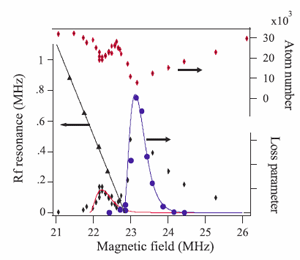 |
Radio-frequency association of molecules: the dressed state pictureWe develop a theoretical model to describe the radio-frequency (rf) induced coupling of a pair of colliding atoms to a Feshbach molecule when a magnetic field arbitrarily far from the Feshbach resonance is modulated in time. We use the dressed atom picture, and show that the coupling strength in presence of rf is equal to the Feshbach coupling strength multiplied by the square of a Bessel function. The argument of this function is equal to the ratio of the atomic rf Rabi frequency to the rf frequency. We experimentally demonstrate this law by measuring the rate of rf-association of molecules using a Feshbach resonance in d-wave collisions between ultra-cold chromium atoms. |
 |
A Feshbach resonance in d-wave collisions We analyse a narrow Feshbach resonance with ultra-cold
chromium atoms colliding in d-wave. The resonance is made
possible by dipole-dipole interactions, which couple an
incoming l = 2 collision channel with a bound molecular
state with l = 0. We find that three-body losses associated
to |
 |
Radio-frequency induced ground state degeneracy in a Chromium Bose-Einstein condensateWe study the effect of strong radio-frequency (rf) fields on a Bose-Einstein condensate (BEC) of chromium atoms, in a regime where the rf frequency is much larger than the Larmor frequency. We use the modification of the Landé factor by the rf field to bring all Zeeman states to degeneracy, despite the presence of a static magnetic field of up to 100 mG. This is demonstrated by analyzing the trajectories of the atoms under the influence of dressed magnetic potentials in the strong-field regime. We investigate the problem of adiabaticity of the rf dressing process and relate it to how close the dressed states are to degeneracy. Finally, we measure the lifetime of the rf dressed BECs and identify a rf-assisted two-body loss process induced by dipole-dipole interactions. |
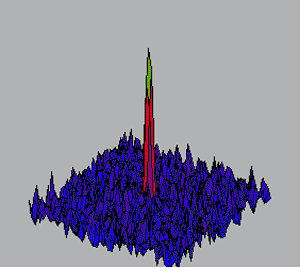 |
Recent observation of a BEC of 52CrWe report on the production of 52Cr Bose Einstein Condensates with an all-optical method. We first load 5.106 metastable chromium atoms in a 1D far-off-resonance optical trap from a Magneto Optical Trap, by combining the use of Radio Frequency frequency sweeps and depumping towards the 5S2 state. The atoms are then pumped to the absolute ground state, and transferred into a crossed FORT in which they are evaporated. The fast loading of the 1D FORT (35 ms 1/e time), and the use of relatively fast evaporative ramps allow us to obtain in 20 s about 15000 atoms in an almost pure condensate. |
 |
11/07 Averaging out magnetic forces with fast RF-sweepsUsing fast RF-sweeps, we show that we can cancel out the forces acting on atoms trapped in a magnetic trap. Using this, we can accumulate from a MOT two millions metastable chromium atoms in a pure optical trap. |
 |
11/07 A magnetic lens dressed by rf fields
Using RF fields in combination with DC inhomogeneous fields allow to engineer new magnetic potentials. We have realised a magnetic lens 'dressed by rf'. The focal length can be tuned by changing only the RF frequency value. |
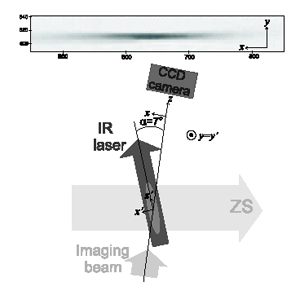 |
Accumulation of chromium metastable atoms into an Optical TrapWe have realised the fast accumulation of a large number of metastable 52Cr atoms in a mixed trap, formed by the superposition of a strongly confining optical trap and a quadrupolar magnetic trap. The steady state is reached after about 400 ms, providing a cloud of more than one million metastable atoms. |
Accumulation and thermalization of cold atoms in a finite-depth magnetic trapWe experimentally and theoretically study the continuous accumulation of cold atoms from a magneto-optical trap into a finite depth trap, consisting in a magnetic quadrupole trap dressed by a radiofrequency field. Chromium atoms (52Cr) in a MOT are continuously optically pumped by the MOT lasers to metastable dark states. |
|
  |
Simultaneous Magneto-Optical Trapping of Bosonic and Fermionic Chromium AtomsWe have realised the first simultaneous magneto-optical trapping of bosonic 52Cr and fermionic 53Cr atoms. The two pictures on the left are fluorescence pictures of our MOT cloud for N=4.106 bosons and 5.104 fermions at a temperature of 120 microK |
